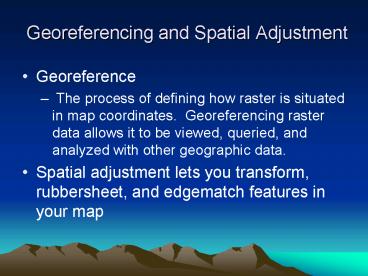Georeferencing and Spatial Adjustment - PowerPoint PPT Presentation
1 / 20
Title:
Georeferencing and Spatial Adjustment
Description:
Affine Transformation ... parallelism, the affine transformation allows ... Affine transformation. x' = Ax By C y' = Dx Ey F. A = Sxcos(t) B ... – PowerPoint PPT presentation
Number of Views:333
Avg rating:3.0/5.0
Title: Georeferencing and Spatial Adjustment
1
Georeferencing and Spatial Adjustment
- Georeference
- The process of defining how raster is situated
in map coordinates. Georeferencing raster data
allows it to be viewed, queried, and analyzed
with other geographic data. - Spatial adjustment lets you transform,
rubbersheet, and edgematch features in your map
2
Geometric Transformation
- Geometric transformation is the process of
converting a digital map from one coordinate
system to another by using a set of control
points and transformation equations. - There are several types of transformations
3
Control Points
- Links that define common points in each
coordinate system. - The corners of a map are very often used
- A USGS 7.5 minute quad has 16 tic marks that can
be used to georeference a map - Control points should be distributed over the
area of interest .
4
Equiarea Transformation
- Equiarea (congruence) Transformation
- The method allows rotation of the rectangle and
preserves its shape and size.
5
Similarity Transformation
- Similarity Transformation
- The method allows rotation of the rectangle and
preserves its shape but not size.
6
Affine Transformation
- Affine Transformation
- The method allows angular distortion but
preserves the parallelism of lines. - While preserving line parallelism, the affine
transformation allows rotation, translation,
skew, and differential scaling on the rectangular
object.
7
Projective Transformation
- Projective Transformation
- The method allows angular and length distortion,
thus allowing the rectangle to be transformed
into an irregular quadrilateral.
8
Topological Transformation
- Topological Transformation
- The method preserves the topological properties
of an object but not shape, thus allowing the
rectangle to be transformed into a circle. - Also called rubber sheeting
9
First Order Polynomial Transformation
- Affine transformation
- x Ax By C y Dx Ey F
- A Sxcos(t)
- B Syk cos(t) sin(t)
- D Sxsin(t)
- E Syk sin(t) cos(t)
- C Translation in x direction
- F Translation in y direction
- k sheer factor Skew angle arctan(k)
- Sx Scale factor in x direction
- Sy Scale factor in y direction
10
Matrix Estimation of Transform Coefficients
C F A D B E
N Sx Sy Sx Sx2 Sxy Sy Sxy Sy2
-1
SX SY SxX SxY Sy SyY
.
11
RMS Root Mean Square error
- RMS for a tic sqrt((xact xest)2 (yact
yest)2) - Averaage RMS sqrt((S(xact,i-xext,i)2
S(yact,i yest,i)2 /n)
12
Higher order polynomial transformation
- Named for the largest exponent in the
transformation equation. - ArcMap supports first to third order
transformation. - Command line supports first to twelfth order
transformation. - Use the lowest order transformation that provides
acceptable results - Number of control points required is
- N (p 1)(p 2) / 2
13
Orthorectification
- Process for correcting aerial an satellite
imagery - Correct for viewing angle, elevation distortion,
and camera geometry - Requires ground control points, camera report,
and DEM. - ArcGIS transformation methods do not correct for
elevation distortion - ArcGIS does not support Orthorectification. If
you need to Ortho correct an image use another
product like Erdas Imagine, GRASS
14
Georeferencing Process
- Create Links
- Look at the link table for acceptable RMS on each
Point. - Remove links with error that is to high
- It is better to keep a link that you are sure is
correct. If a link has a high RMS but is
correctly located on the image removing it will
improve the reported RMS but add error to the
map. - Select the order of transformation
- Rectify the map selecting the resample method
15
Resampling Process
16
Spatial Adjustment
17
(No Transcript)
18
Address Geocoding
- More than 80 of all data stored in the world has
a spatial attribute - The vast majority of that data uses an address as
its spatial attribute - Address Geocoding is the process of converting an
address to a location in map space.
19
Requirements for Address Geocoding
- A street coverage with address ranges
- A database with addresses in a form the geocoding
engine can parse.
20
Geocoding Process
- The Geocoding engine searches the data for
candidate address - The candidate address are scored
- The candidate with the best score is added to the
map if that score is greater than the minimum
match score































